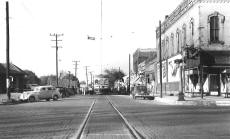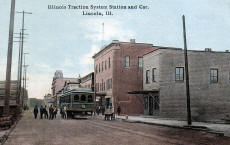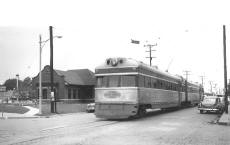_small.jpg)
Jenkins
is a former employee of the
Illinois Terminal Railroad and
founder and current president of
the Illinois Traction Society.
Jenkins is also the author of a
magnificent book on the Illinois
Terminal Railroad called "The
Illinois Terminal Railroad: The
Road of Personalized Services."
Jenkins' interest in
railroading, the Illinois
Terminal in particular, began in
childhood in his hometown of
Springfield. As a child he was
fascinated by the trains passing
close to his house -- so
intrigued that he would sit on
the rails waiting for the next
train to come along.
A friendly and concerned
Illinois Terminal Railroad
policeman took him under his
wing to ensure his safety.
Later, with the retirement of
his mentor just as Jenkins
graduated from high school, he
took over his friend's job with
the railroad. Jenkins spent 40
years as a railroad policeman
with the Illinois Terminal and
its follow-on companies. Upon
retirement, he undertook to tell
the story of the IT, some of
which concerned the city of
Lincoln.

In the late 19th century,
electric streetcars were
becoming common in the United
States. Lincoln had an extensive
system. Trolleys trundled all
over Lincoln, even going as far
west as the Chautauqua grounds,
currently Memorial Park. The
system ran in Lincoln from 1891
until 1928, when improved
streets and the growing use of
personal automobiles made the
streetcar line unprofitable.
In 1901, a Danville
entrepreneur named William
McKinley had a vision of what
the United States would become,
a vision that saw the increased
use of electricity to make the
lives of ordinary Americans
better. He bought his first
electric generating power plant
in 1901 in Danville.
Of course, a power plant
requires fuel, and the fuel of
choice in the early 20th century
was coal. The closest coal mine
to Danville was south of the
city.
Roads being what they were at
the time, transporting coal from
the mine to Danville was
difficult. McKinley came up with
the idea of building an electric
railroad from his power plant to
the coal mine. Many of the
miners were Danville residents,
so the train carried the miners
south to the mine and the coal
north to his power plant.
McKinley was not satisfied
with owning one power plant, but
began to amass plants in many
cities in central Illinois. He
was ushering in the modern age
of electricity to the homes and
businesses of the area. As with
most imaginative businessmen, he
saw the potential of the small
electric railroad he had created
in Danville and decided to
expand it to the west, initially
connecting Danville and
Champaign, then Decatur.
A few other like-minded men
had created small electric
railroads in central Illinois,
but they were for the most part
unsuccessful. McKinley began
buying these poorly run lines
and linking them together. It
can safely be said that he was
an organizational genius who
could look into the future and
predict what central Illinois
needed to grow, thus expanding
his own enterprises.
Eventually, McKinley's
railroad empire, called the
Illinois Traction System, would
link Danville, Champaign,
Decatur, Springfield, Peoria and
Lincoln to East St. Louis and
finally St. Louis. This electric
railroad became known as the
interurban.
The interurban tracks on the
line from Peoria to Springfield
passed through Lincoln, right
down the middle of Chicago
Street, entering Lincoln from
the north and curving south
where Chicago Street ended at
the Stetson China factory.
The original interurban depot
still stands on South Chicago
Street -- a block building
standing by itself just north of
Baker Masonry. Back in the day,
the station stood next to the
Commercial Hotel, one of the
premier lodging businesses in
Lincoln at the time.
By 1908, 26 interurban trains
a day passed through Lincoln
from 5:30 a.m. to 11:30 p.m.
They took residents at a stately
25 mph to Peoria and Springfield
and points south. Roads were
abysmal at the time, so these
one- and two-car passenger
trains drawing power from an
overhead electric line were a
convenient and efficient means
to travel.
While the ITS tracks ran
parallel in some places to the
much larger Chicago & Alton
Railroad -- later to become the
Gulf, Mobile & Ohio -- the
interurban offered service that
the steam-powered passenger
trains could not.

The ITS prided itself on
personalized service, letting
passengers off at the tiny towns
such as Broadwell and Elkhart
along its right of way.
Richard Martin, a Logan
County resident and farmer,
remembers riding the interurban
from his home in Broadwell to
Lincoln. The trains would even
stop in the country to pick up
lone passengers needing a ride
from their farm into Lincoln.
Lincoln resident Bill
"Carlos" Gobleman remembers
boarding the interurban in
Lincoln with his shotgun, paying
35 cents and riding to Broadwell.
"I would then walk back to
Lincoln along the railroad and
hunt," he said.
Willard Emmons recalls his
father and sister riding the
interurban from Lincoln to
Peoria for their jobs during the
1940s. His father worked at
Caterpillar, and his sister
worked at a bag factory. They
traveled to Peoria early in the
week, stayed in an apartment
during the week, then traveled
home to Lincoln at the end of
the workweek.
[to
top of second column] |

The Illinois Traction System
became the Illinois Terminal
Railroad in the 1920s.
Jenkins related how McKinley
was not satisfied with just
carrying passengers on his
interurban. He offered same-day
package delivery service between
towns on his line. He also
initiated a small freight
service to increase the utility
of his railroad. The main
commodities carried were grain
and gravel.
McKinley's decision to begin
a freight service proved to be
prophetic.
McKinley began buying grain
elevators to integrate into his
growing central Illinois empire.
Bus service was also added when
roads were improved enough to
allow it.
In addition to providing
transportation and freight
service to Lincoln residents,
Jenkins related how the IT
brought entertainment to town.
Lincoln was on the vaudeville
circuit in the early 20th
century. When a vaudeville
troupe ended their evening show
in Peoria, they would tear down
and put their sets on the
electric railroad with the
performers to ride to Lincoln
for the next day's performance
at either the Grand or Lincoln
Theater.
As the years passed, the
interurban had increasing
competition from the expanding
use of the automobile, made
possible by the improvement in
intercity roads -- think Route
66 and other highways. By the
1930s, daily passenger train
service in Lincoln from the
Illinois Terminal dropped to 16
times a day.
The company tried to fight
back by increasing the luxury of
the passenger cars and
developing innovative services
such as lounge cars and air
conditioning.
The ITS was also the first
electric railroad in the world
to offer sleeping car service. A
passenger could board the
interurban in Lincoln in the
evening, enjoy a night's sleep
onboard and be in St. Louis the
next morning after crossing the
Mississippi River on the
McKinley Bridge, built by
William McKinley's personal
fortune.

But it was not enough.
After World War II, with the
increase in cars and decent
roads and the introduction of
more efficient diesel railroad
locomotives, the electric
passenger railroad in central
Illinois was doomed. Even with
the introduction of the fast and
luxurious Streamlines in the
late 1940s, McKinley's passenger
trains declined rapidly until
interurban passenger service in
Lincoln ended on June 11, 1955.
Lincoln railroading
enthusiast Paul Hines has the
distinction of being the last
passenger to step off the last
passenger interurban in Lincoln.
With the addition of a small
freight service early in the
20th century, the Illinois
Terminal burgeoned. Freight took
over from the passenger service
when the passenger trains ended
their service in the 1950s. For
many years after, the IT freight
trains chugged down Chicago
Street, pulled by the
distinctive green and yellow
diesel engines.
After 1962, the freight
service moved from Chicago
Street to the Illinois Central
tracks on the east side of
Lincoln. All that remained on
Chicago Street were the rails,
with the street now given over
entirely to cars.
The rails on Chicago Street
are now gone, but two remnants
of the era of electric passenger
service remain in Lincoln. The
aforementioned passenger depot
still stands, and a brick
electric substation is hidden
away on the southwest end of
Chicago Street, on property
owned by the Logan County
Highway Department.
There is also a combination
interurban depot and substation
at Union, nine miles north of
Lincoln.
For those who want to
experience a ride on the
interurban, a visit to the
Illinois Railway Museum is a
must. The museum has several
examples of interurban trains
that run. The museum is located
in the community of Union that
is west of Chicago. Note that it
is not the Union north of
Lincoln.
Dale Jenkins' lecture on
electric passenger rail service
in Lincoln is one of an ongoing
series of programs presented by
the Logan County Genealogical &
Historical Society at their
monthly meetings. The
organization is based at 114 N.
Chicago St. in Lincoln. Check
the website at
www.logancoil-genhist.org
for upcoming events at the
research center.
More information on the
Illinois Traction Society is
available at
www.illinoistractionsociety.org.
The Illinois Railway Museum's
website is at
www.irm.org.
[By CURT FOX]


 |